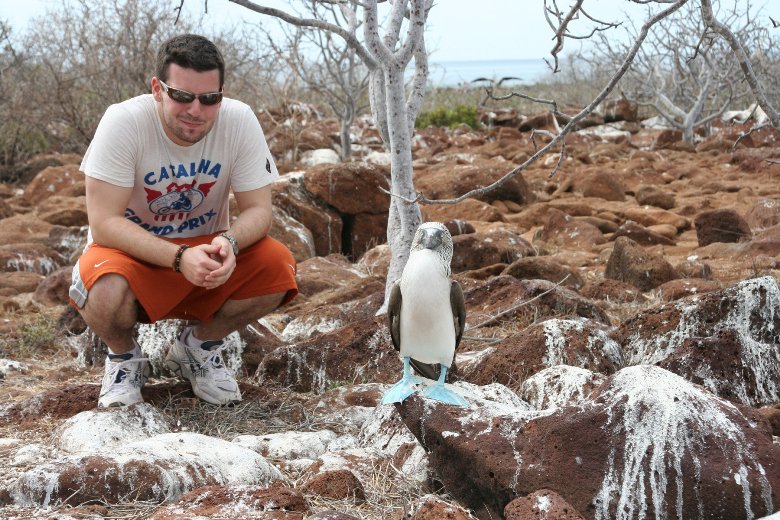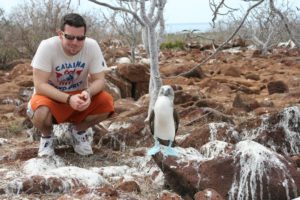By Eileen Ogintz
Tribune Media Services
Have you ever gone to a party on the wrong day? When we arrive Christmas afternoon, the hosts and their kids clearly aren’t expecting company. In fact, we catch them snoozing. But we barge in anyway — we have come so far, after all, to see them. Our hosts, the Sea Lion family, live on San Cristobal island in the Galapagos and they’re everywhere on the otherwise deserted beach and the rocks — mamas and pups nursing, adolescents swimming, fathers marking their territory. We’re mindful of our guide’s warning to stay 20 yards away.
In the water, they swim rings around us. It’s one of those rare I-can’t-believe-we’re-here-doing-this moments in a holiday week filled with memorable moments touring these remote islands off the coast of Ecuador where the wildlife inspired Charles Darwin’s life’s work.
We pose with giant tortoises that ignore our presence, and step around the marine iguanas sunning themselves on the rocks on another island. We crouch next to Blue-Footed Boobies (yes their feet are bright blue). We hike over black lava fields and snorkel with sea turtles and stingrays.
So many families are now seeking such adventures – despite the considerable cost (typically well over $10,000 for a family of four), that more yacht owners operating in the Galapagos Islands and outfitters are adding special family amenities and departures, says Kurt Kutay, president of Wildland Adventures (www.wildland.com) and a member of the Trusted Adventures consortium (www.trustedadventures.com) who helped organize our trip. Adventure companies like Wildland Adventures, Austin-Lehman Adventures (www.austinlehman.com), Tauck Bridges (www.tauckbridges.com), Abercrombie and Kent (www.abercrombiekent.com) and Thomson Family Adventures (www.familyadventures.com) report increasing interest in trips designed for families.
But even this trip isn’t perfect. One daughter nearly missed the boat because a blizzard delayed her flights for three days. The Flamingo, our 83-foot boat (www.ecoventura.com), which holds 20 passengers and 11 crewmembers, rocks and rolls, the cabins are small. The siblings bicker. There’s no entertainment except what we supply ourselves. (Scrabble anyone?) No one comes around with fruity concoctions. The food could be better.
That’s all part of the adventure, I think. It’s the missteps as well as the stellar moments that make taking the kids so memorable. And navigating those missteps – whether in a remote locale like the Galapagos or close to home — helps teach the kids that they can manage just fine in unfamiliar turf — when the expensive tour is a complete dud (according to the kids anyway), the passports get stolen, or someone gets sick at the most inopportune time. (Yes, that all happened to us this past year.)
That’s all the more reason to savor the stellar moments (are we really swimming with sea lions? Could there be a better place to buy stocking stuffers than the sprawling outdoor market so far from home?
Artisans come to Otavalo, about two hours north of Quito, the capital of Ecuador, from miles around. We stop and see local Ecuadorians trading pigs (about $85), lambs ($60) and even cows (about $200). Many locals are dressed in traditional Ecuadorian dress — long braids coiled with bright weavings, embroidered shirts and dark skirts and shawls. The old women have gold colored beads wound around their necks and strings of red coral around their wrists. They’re said to ward off evil spirits.
The market stretches for 15 blocks in the town of 45,000 people and everything imaginable is for sale – silver jewelry, piles of multicolored scarves, woven bags, alpaca sweaters and socks, knit hats, Ecuadorian dolls, painted boxes, beads and drums. We bargain but clearly the sellers have prices in mind. Still everything is incredibly cheap by U.S. standards — $2 for a woven bag, $3 for silver earrings. I could have stayed longer but after a couple of hours mingling in the crowd my gang is ready to leave, loaded down with sweaters and hats, embroidered shirts and bracelets. We stay nearby in the restored Hacienda Cusin (www.haciendacusin.com) owned by a former American teacher.
I’m grateful for the chance to share such an adventure with those I love — and for the time together. I can’t remember the last holiday that we spent so much time together or the last New Year’s Eve we celebrated as a family. But here, the kids have no choice and they don’t seem to mind a bit. Just back from the Galapagos Islands, we’re spending the night in a restored home, now a small, charming hotel (www.cafecultura.com) in Quito, a city surrounded by snow-capped volcanoes but less than 20 miles from the Equator and just a short walk from the city’s festivities.
What a scene! It turns out that in Ecuador it’s the custom to make giant puppets of politicians, sports stars, TV characters and superheroes – and then burn them at midnight. “The idea is to burn away the bad things,” explains our guide Ingrid Proano. Men dressed in drag dance in front of cars asking for money. We walk through the crowd on Avenue Amazonas, which is as crowded as Times Square with parents with kids on their shoulders, teens with fireworks and couples hand in hand. People from the highlands sell colorful woolen hats, sweaters and scarves, dolls dressed in traditional dress, bead necklaces and bracelets, as well as fireworks and food and there is steamed corn and potatoes, grilled meat and pork and fried plantains.
And all along the way are the giant puppets. There’s the Ecuadorian soccer team on one street; locals traveling by bus to Quito in another (a presentation of improved roads, we’re told), politicians and even oil company workers. We buy funny-jeweled masks for 50 cents and horn headbands with sparkles.
Just before midnight, we gather in the library of our hotel, the TV turned to CNN and toast the new year, and new adventures together.
© 2007 EILEEN OGINTZ, DISTRIBUTED BY TRIBUNE MEDIA SERVICES, INC.


